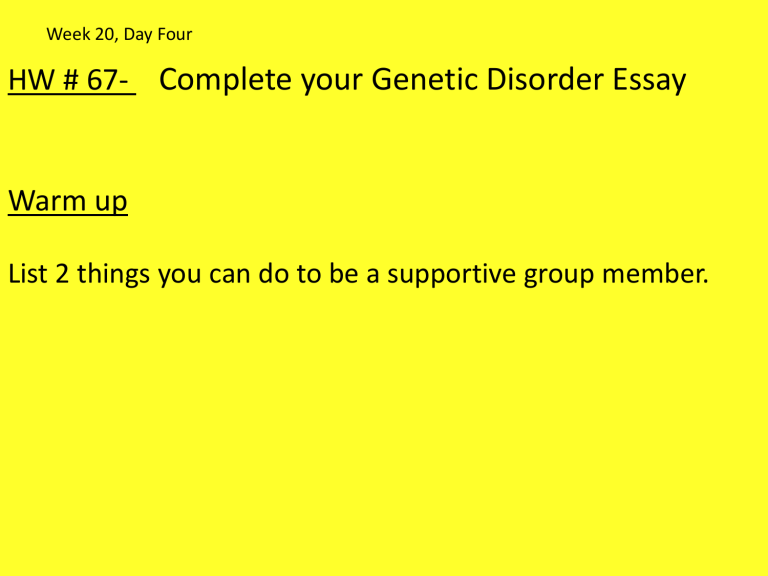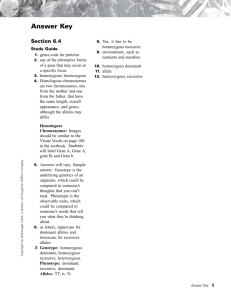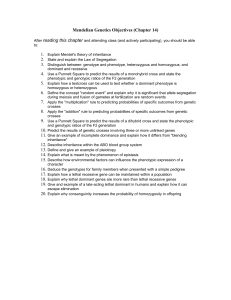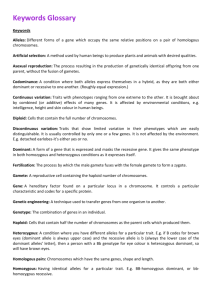Document

Week 20, Day Four
HW # 67-
Complete your Genetic Disorder Essay
Warm up
List 2 things you can do to be a supportive group member.
x
Warm up Response
Homework Response/Check
Did you complete your individual research?
• Genetic Disorder Essay
• Work with the other people in class who have the same disorder
• Produce 1 essay in GoogleDocs (shared with all group members AND me) – EDITING
• This is a quick write. We will not be doing revisions. However, you need to work collaboratively and put your very best work forward.
• Be sure to read the online prompt and rubric!
Stop here
The rest is for next week on Punnett squares
Punnett Square and Probability
• Used to predict the possible gene makeup of offspring –
Punnett Square
• Example: Black fur (B) is dominant to white fur (b) in mice
1. Cross a heterozygous male with a homozygous recessive female.
Black fur ( B )
Heterozygous male
White fur ( b )
White fur ( b )
Homozygous recessive female
White fur ( b )
Male =
Bb X Female = bb
Male gametes - N
(One gene in sperm)
B b b
Bb Bb b bb bb
Female gametes – N
(One gene in egg)
Possible offspring – 2N
Genotypic ratio = 2 Bb : 2 bb
50% Bb : 50% bb
Phenotypic ratio = 2 black : 2 white
50% black : 50% white
Write the ratios in the following orders:
Genotypic ratio homozygous : heterozygous : homozygous dominant recessive
Phenotypic ratio dominant : recessive
Cross 2 hybrid mice and give the genotypic ratio and phenotypic ratio.
B b
Bb X Bb
B
BB Bb b
Bb bb
Geno typic ratio = 1 BB : 2 Bb : 1 bb
25% BB : 50% Bb : 25% bb
Pheno typic ratio = 3 black : 1 white
75% black : 25% white
Example: A man and woman, both with brown eyes (B) marry and have a blue eyed (b) child. What are the genotypes of the man, woman and child?
Bb
X
Bb
Man =
Bb
Woman =
Bb
B
B
BB b
Bb b Bb bb
Crossing involving 2 traits – Dihybrid crosses
• Example: In rabbits black coat (B) is dominant over brown (b) and straight hair (H) is dominant to curly (h). Cross 2 hybrid rabbits and give the phenotypic ratio for the first generation of offspring.
Possible gametes:
BbHh X BbHh
BH BH
Bh Bh bH bh bH bh
Gametes
BH
BH
BBHH
Bh
BBHh bH
BbHH bh
BbHh
Bh BBHh BBhh BbHh Bbhh Phenotypes - 9:3:3:1
9 black and straight
3 black and curly
3 brown and straight
1 brown and curly bH bh
BbHH
BbHh
BbHh
Bbhh bbHH bbHh bbHh bbhh
• Example: In rabbits black coat (B) is dominant over brown (b) and straight hair (H) is dominant to curly (h). Cross a rabbit that is homozygous dominant for both traits with a rabbit that is homozygous dominant for black coat and heterozygous for straight hair. Then give the phenotypic ratio for the first generation of offspring.
BBHH X BBHh
Possible gametes: BH BH
Bh
Phenotypes:
100% black and straight
BH
BH Bh
BBHH BBHh
Gametes
Gametes
(Hint: Only design Punnett squares to suit the number of possible gametes.)
Sex Determination
• People – 46 chromosomes or 23 pairs
• 22 pairs are homologous (look alike) – called autosomes – determine body traits
1 pair is the sex chromosomes – determines sex (male or female)
• Females – sex chromosomes are homologous (look alike) – label XX
Males – sex chromosomes are different – label XY
• What is the probability of a couple having a boy? Or a girl?
Chance of having female baby? 50% male baby? 50%
X
X X
XX XX
Y XY XY
Who determines the sex of the child? father
Incomplete dominance and Codominance
• When one allele is NOT completely dominant over another (they blend ) – incomplete dominance
Example: In carnations the color red (R) is incompletely dominant over white (W). The hybrid color is pink. Give the genotypic and phenotypic ratio from a cross between 2 pink flowers.
W
RW X RW
R
R RR RW
W RW WW
Genotypic = 1 RR : 2 RW : 1 WW
Phenotypic = 1 red : 2 pink : 1 white
• When both alleles are expressed – Codominance
Example: In certain chickens black feathers are codominant with white feathers.
Heterozygous chickens have black and white speckled feathers.
Sex – linked Traits
• Genes for these traits are located only on the X chromosome (NOT on the Y chromosome)
• X linked alleles always show up in males whether dominant or recessive because males have only one X chromosome
• Examples of recessive sex-linked disorders:
1. colorblindness – inability to distinguish between certain colors
You should see 58
(upper left), 18
(upper right), E
(lower left) and 17
(lower right).
Color blindness is the inability to distinguish the differences between certain colors. The most common type is red-green color blindness, where red and green are seen as the same color.
2.
hemophilia
– blood won’t clot
• Example: A female that has normal vision but is a carrier for colorblindness marries a male with normal vision.
Give the expected phenotypes of their children.
N = normal vision n = colorblindness X N X n
X
X N Y
X N X n
X N
X N X N X N X n
Y X N Y X n Y
Phenotype: 2 normal vision females
1 normal vision male
1 colorblind male
Pedigrees
• Graphic representation of how a trait is passed from parents to offspring
• Tips for making a pedigree
1. Circles are for females
2. Squares are for males
3. Horizontal lines connecting a male and a female represent a marriage
4. Vertical line and brackets connect parent to offspring
5. A shaded circle or square indicates a person has the trait
6. A circle or square NOT shaded represents an individual who does NOT have the trait
7. Partial shade indicates a carrier – someone who is heterozygous for the trait
• Example: Make a pedigree chart for the following couple. Dana is color blind; her husband Jeff is not.
They have two boys and two girls.
HINT: Colorblindness is a recessive sex-linked trait.
X n X n X N Y
Has trait Can pass trait to offspring
Multiple Alleles
• 3 or more alleles of the same gene that code for a single trait
• In humans, blood type is determined by 3 alleles – A , B , and O
BUT each human can only inherit 2 alleles
1. Dominant – A and B (codominance)
Recessive – O
2 .
Blood type – A = AA or AO
B = BB or BO
AB = AB
O = OO
Example: What would be the possible blood types of children born to a female with type AB blood and a male with type O blood?
AB
X
OO
O
A B
AO BO
O AO BO
Children would be type A or B only
Mutations
• Mutation – sudden genetic change (change in base pair sequence of DNA )
• Can be :
Harmful mutations – organism less able to survive: genetic disorders, cancer, death
Beneficial mutations – allows organism to better survive : provides genetic variation
Neutral mutations – neither harmful nor helpful to organism
• Mutations can occur in 2 ways: chromosomal mutation or gene/point mutation
Chromosomal mutation:
• less common than a gene mutation
• more drastic – affects entire chromosome , so affects many genes rather than just one
• caused by failure of the homologous chromosomes to separate normally during meiosis
• chromosome pairs no longer look the same – too few or too many genes, different shape
• Examples:
Down’s syndrome – (Trisomy 21) 47 chromosomes, extra chromosome at pair #21
Turner’s syndrome – only 45 chromosomes, missing a sex chromosome (X)
Girls affected – short, slow growth, heart problems
Klinefelter’s syndrome – 47 chromosomes, extra X chromosomes (XXY)
Boys affected – low testosterone levels, underdeveloped muscles, sparse facial hair
• Having an extra set of chromosomes is fatal in animals , but in plants it makes them larger and hardier .
Hardier
Gene or Point Mutation
• most common and least drastic
• only one gene is altered
• Examples:
Recessive gene mutations:
Sickle cell anemia – red blood cells are sickle shaped instead of round and cannot carry enough oxygen to the body tissues
– heterozygous condition protects people from malaria
Cystic fibrosis – mucous builds up in the lungs
Tay-Sachs Disease – deterioration of the nervous system – early death
Mutated genes produce enzymes that are less effective than normal at breaking down fatty cell products known as gangliosides. As a result, gangliosides build up in the lysosomes and overload cells. Their buildup ultimately causes damage to nerve cells.
Phenylketonuria (PKU) – an amino acid common in milk cannot be broken down and as it builds up it causes mental retardation – newborns are tested for this
Dominant gene mutations:
Huntington’s disease – gradual deterioration of brain tissue , shows up in middle age and is fatal
Dwarfism – variety of skeletal abnormalities
Detecting Genetic Disorders
• picture of an individual’s chromosomes – karyotype
• amniotic fluid surrounding the embryo is removed for analysis – amniocentesis
Female with Down’s syndrome








